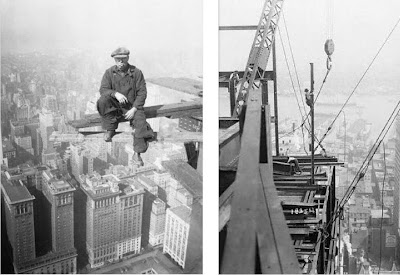
In Paul Engineer interesting conference given last Otaola Ubieta 21 May in the Demarcation of Tenerife, La Gomera and El Hierro the COAC, with the title "The transformation of the city", emphasis was placed on the role of local management in implementing the planning. This exposed several interventions where this aspect had been instrumental in its development. The transformation of Bilbao Bilbao 2000 and Zorrotzaurre, and the IBA Emscher Park in the Ruhr, were some of ellas.Esta last was undoubtedly the greatest interest awakened in me, perhaps because the transformation of Bilbao nearest me and family.
IBA Emscher Park is the name given to the metamorphosis of the old industrial region of the Ruhr, Germany, between 1989 and 1999. It creates a large territorial park involving more than 80 communities, in order to restore one of the most degraded landscapes across Europe. It became a symbol and a stimulus for urban change, economic, social and environmental.
 Ruhr Ruhr
The Land Art or art of landscape construction is very present in this intervention. The IBA convened several international competitions to select artworks to install in this unique landscape. This caused some controversy among the public to see how invested large amount of money to hire artists to design lighting obsolete industries or extravagant sculptures, instead of using it in housing or other social needs.
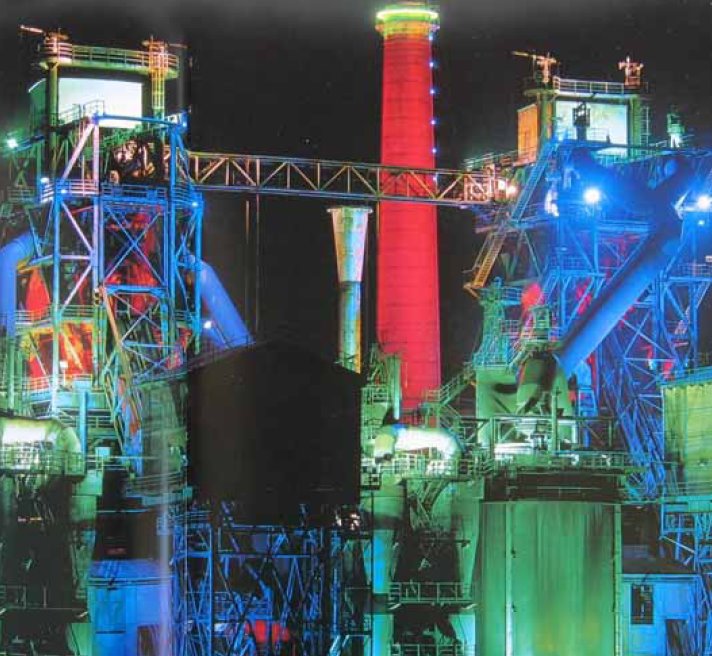
Floodlit
However, this commitment to art helped reinforce the innovative online initiative and gave the large park of a system of milestones in the landscape. Many of these milestones and sculptures are made with industrial artifacts rather, strengthening the connection with the area and its history. Abandoned industries also became new attractions for visitors; engineering works of yesteryear with high cultural value. All this within the strategy to regenerate the economy and the environment degraded territory, enhancing the original character of the place.
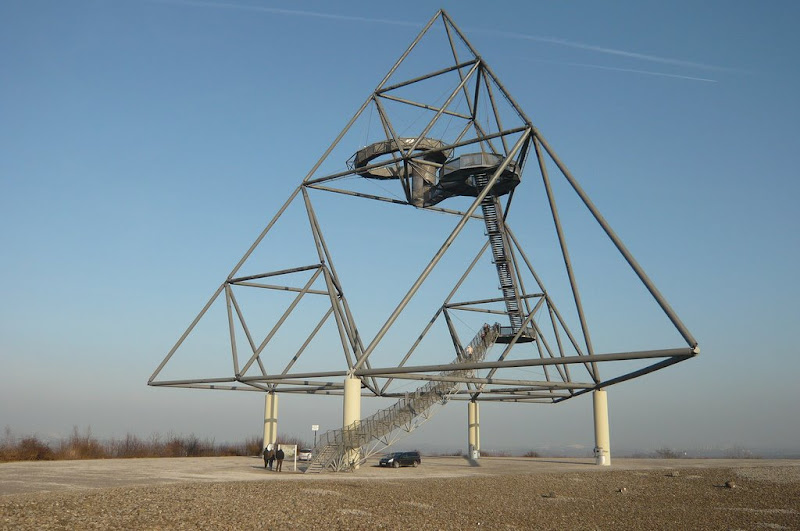
Tetrahedron. Photos: Flickr
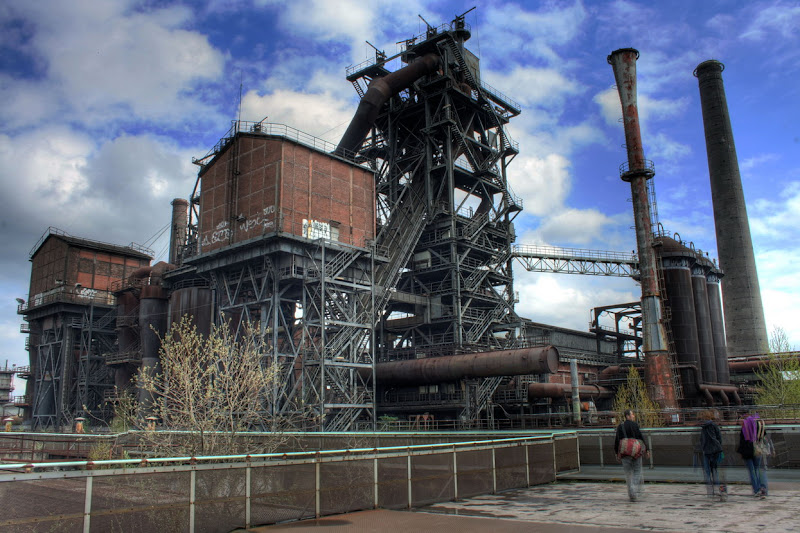
Industry as a place of cultural interest. Photos: Flickr
The image I found most attractive was the installation lecture called "The Wall" of the artist couple Christo and Jeanne Claude, textile specialists use to wrap gigantic buildings or public areas cover large, as his works "Valley Curtain", "Surrounded Islands" or the covering of the Reichstag in Berlin. But this facility is not used in textiles, was to be divided into two a gasometer, by a huge wall made up of barrels of oil. This gasometer Emscher Park is one of the largest tank-shaped structures of the world. It was built in 1928 and is now used as an exhibition space. Its structure is 110 m high with a diameter of 68 meters. Definitely a spectacular space.

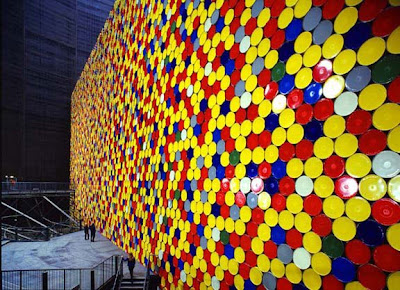
The Wall, Christo and Jeanne Claude
For the realization of this wall were used 13.000 colored barrels. In addition to this installation documentation presented two works by the artists mentioned in other countries, "The Umbrellas" (Japan) and the covering of the Reichstag (Germany).
In this way it was possible to transform this already if unusual space.
 The electronic reader PlasticLogic will market during the summer of 2009 The electronic reader PlasticLogic will market during the summer of 2009
Reading buffs are about to undergo a radical change in the way we relate to the details.Rarely supports my opinion, magazines and newspapers made on cellulose paper will begin to reduce their presence among us. A first step of this process have already established electronic reading devices first generation, such as the Sony Reader and the Kindle, marketed by Amazon. Widgets that offer a similar reading to that offered paperback books in black and white. They have had the disadvantage of very specific format with scarce supply with excessive weight and, thus, its implementation among potential users has not been all that seems expands.
All these disadvantages will gradually disappearing with the emergence of more effective new devices that will allow for a similar reading of newspapers, but with many added benefits not currently experienced. The possibility of multiple links along with audio and high quality video on demand.
 The new Amazon Kindle The new Amazon Kindle
New proposals to facilitate digital reading will move this year to the electronics market. It is called electronic ink to be supported by high-strength plastic substrates and low weight. This technology, marketed by the American company E-Ink, allows high versatility of images and compositions. It is what is already a billing from magazines like Fortune (you can see a reference to it in the magazine this week Spanish Capital) in which are displayed and analyzed e-readers like the e-reader business PlasticLogic.In a few years, the ideas advanced by recent films like Minority Report science fiction or full Red Mars will actually among us. In the case of architects, platforms for the design have already returned to retrieve the size of the old drawing board with high resolution screens and larger than one meter. Or the possible emergence of sophisticated plastic planes to the letter renewal of the information presented. They are still products of a high price but it will eventually enter the technical offices.
The problem is that many people do not want to get to interact with all this electronic paraphernalia. This is because it still has a great complexity, many complications and poor quality on devices designed for relationships between men and machines, which creates difficulties and rejection. Many of us will be left behind unable to take advantage of all this technology in permanent mutation. The future belongs to the younger, whose mind has a greater ability to mold to the new realities.
Luckily, all the technology in the world does not guarantee the quality of the ideas that are going to formalize future scenarios. For a long time you will still need to make a new interpretation of the complex reality that is emerging and establish an empathic relationship with the future users.
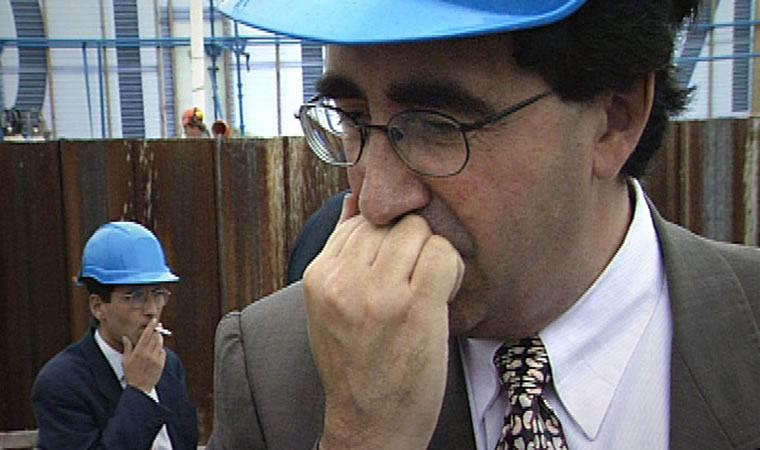
Lately it seems that the architect Santiago Calatrava can not avoid controversy. Since the complaint he made to the city of Bilbao to build a walkway designed by Arata Isozaki, following its Zubi-Zuri bridge, to the criticism in his newly opened bridge Jerusalén.Esta time the focus of the controversy centers on his latest project, a transport of steel and glass for the World Trade Center in New York. Specifically, has been criticized by the New York Times which is described among other things as "heartbreaking" and "monument to the ego". Even provides data on budget, of 1.500 million at 2.530 million. It seems that is not the first time that leaves the budget with a not very convincing design.
 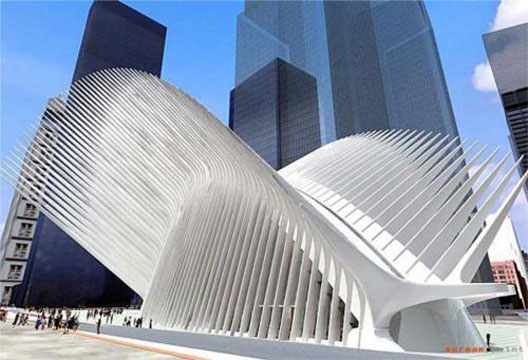
The project consists of a retractable roof ready to open each 11 September in memory of the victims of the attacks. Definitely a "detail" that the budget enormously expensive.
To make matters worse the Queen Sofia Spanish Institute in New York exposed to 31 August an exhibition entitled Santiago Calatrava: World Trade Center Transportation Hub. No doubt the controversy is served.

Shortly after completing one year of age has exceeded our blog 10.000 views. So take this opportunity to thank you for your interest and participation in the issues raised here. We want this blog to remain a space to share all the concerns related to our profession where your comments are vital.
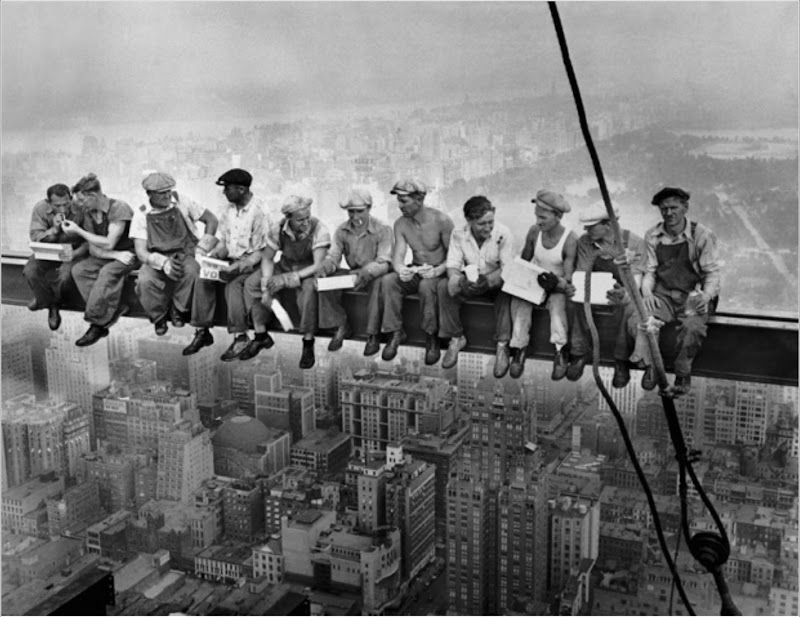 “Almuerzo en un rascacielos” es una de las fotografías más famosas de Charles C. Ebbets, todo un clásico de los pósters que te encuentras habitualmente en tiendas de decoración, librerías etc. La imagen fue tomada en el año 1932 durante la construcción del complejo de edificios comerciales Rockefeller Center, en la planta 69 del Edificio de General Electric y la publicó el New York Herald Tribune en el suplemento dominical . “Almuerzo en un rascacielos” es una de las fotografías más famosas de Charles C. Ebbets, todo un clásico de los pósters que te encuentras habitualmente en tiendas de decoración, librerías etc. La imagen fue tomada en el año 1932 durante la construcción del complejo de edificios comerciales Rockefeller Center, en la planta 69 del Edificio de General Electric y la publicó el New York Herald Tribune en el suplemento dominical .
En ella se ven cómo 11 obreros (al parecer, indios Mohawk e Irlandeses) están descansando sentados sobre una viga de acero a una altura de 244 mts, con la ciudad y el vacío bajo sus pies. Las medidas de seguridad brillan por su ausencia, al no tener ni redes, ni arneses, ni siquiera cascos, where workers take the danger as normal, risking their lives every moment, without any protection and it seems without the slightest concern for their part.
 Resting on a Girder, this time lying napping. Resting on a Girder, this time lying napping.The photos caused a major impact, served to denounce the precarious working conditions of workers in this period of depression in the United States. Most photos are not prepared, are real and correspond to everyday scenes of the workers who participated in the construction of skyscrapers. These images not surprised by what happens in them, but impresses you what can happen.

Charles Ebbets (photographer) born in Alabama (1905-1978) and it was a passion for photography, at eight years old he bought his first camera at a local store, debiting the account that her mother had open, what was a good punishment, but ultimately did not return it and got away with it. In years 30 had already published his photos in the major newspapers in the U.S. and was well known for his graphic work, for which he was hired as director of photography at Rockefeller Center to document the construction of this complex.
These scenes of yesterday, unfortunately continue to be found without the need to go far, is easy to find someone standing on a deck, or scaffold, without the least fear or less protection you can avoid an accident.
Last week was the International Day for Safety and Health ( 28 April ) and served cold to see the previous year's statistics, where despite the downturn in economic activity and the lowest number of employees, fatal accidents increased over the previous year. The main cause of death in construction accident along 2008 were falls from height (42%), followed by impact or crushing deaths (22%). Between 36% remaining listed, mostly, deaths from abuse and those produced as a result of electric shock.
The entry into force in February 1996 Act Occupational Health and Safety was a step forward in terms of integration and Update on Safety Promotion and Health of Workers Preventive incorporating a treatment philosophy of Occupational Hazards and becoming a Statutory Instrument to improve .

The hopes generated by this legislation not only have been fulfilled, but that our country continues to maintain the upward trend in the numbers of workplace accidents despite the improvement over past decades.
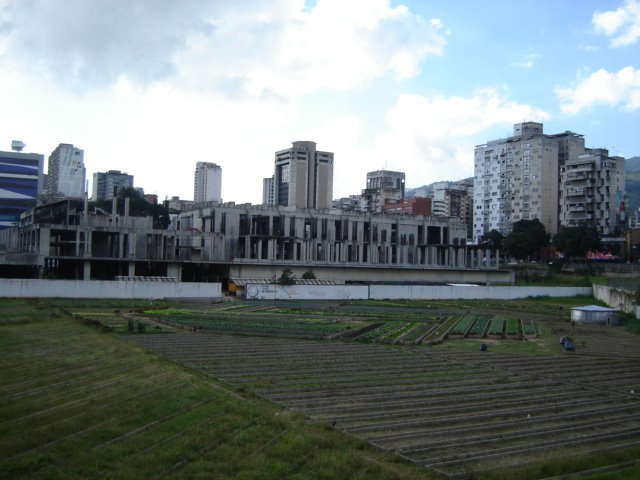
As Federico told us a few months ago on his blog Islands and Territory, one of the measures to combat the crisis is to grow our own food garden básicos.A part of the current economic situation makes us reflect on aspects such, there are other interesting data on the other hand concern should be evaluated in.
For the year 2050, close 80% of the world's population will live in cities. Applying the most conservative estimates of population growth, world population will increase by 3 billion people for these dates. Continuing with current agricultural practices, it takes nearly 1000 million hectares of new land to produce food for this population. According to the FAO and NASA close 80% of productive land are currently in use. That is why we must seek new soils for primary use to cope with the high demand we expected.
Currently there are trends trying to introduce agricultural uses in urban areas or failing in their surroundings. It is what is called peri-urban agriculture or urban. Urban agriculture is not dependent transport of products and is relatively immune to fuel price volatility, impacting heavily on energy efficiency. The product quality tends to improve compared to those of industrial production, preservatives reducing by decreasing displacement. In turn generates employment greatly strengthen local economies.
In cities like Havana in Cuba has resurfaced this agriculture after the destruction of the third part of the island by successive plantings occurring hurricanes. But before the collapse of the Soviet Union had military plans in this regard so that Cuba could be self-sufficient in case of war. Now take advantage as much land available for productive use. They are used to grow each vacant lot, the roofs of buildings and even parking spaces.

Huerta in Havana. City Farmer
This concept of using decks and basements as arable areas has been taken to another level in countries "ultra developed" as Japan. The roofs of large buildings in Tokyo have become authentic plantations also generate employment, help mitigate heating the island. Methods "high-tech" as applied to agriculture hydroponics help get some soil productivity without adequate. Notwithstanding the need for artificial fertilizers hydroponics so sustainability is compromised.
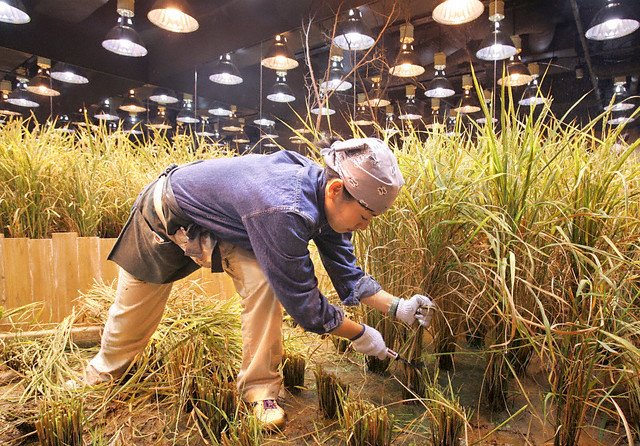
Rice plantation in the basement of a building in Tokyo. Flickr
The application of high technology to agricultural techniques reaches its peak with the appearance of the "vertical crops" (skyfarming). As societies live in vertical cities, raises the idea of creating buildings of a certain height for agricultural production, using the most innovative techniques.
  Proposal for SOA Architects
In many cities the existing spaces have been converted into small gardens trying to raise awareness of its importance. Even in the White House with his new tenant Barack Obama, it was decided to plant a garden, the first since Eleanor Roosevelt cultivated by the Second World War. This seems to want to give example to the public.
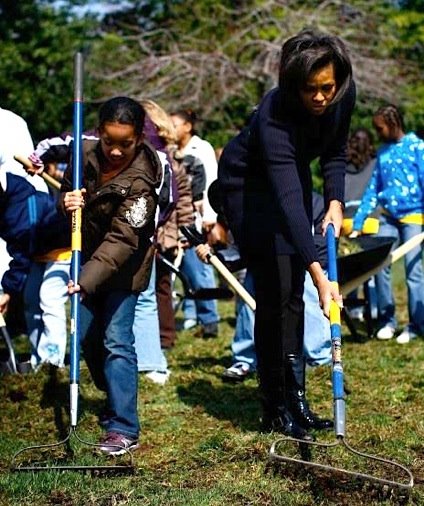 Michelle Obama in her new garden
Michelle Obama in her new gardenWe have seen how agriculture is introduced in cities, yet another issue that would require mention is how to adapt urban growth to rural areas. For example the search for new building types that interact with agricultural environments. Certainly a very interesting and close to our profession in an island territory like ours. I hope someone is encouraged to write about it ...

Valle de Guerra, Tenerife

On countless occasions I had heard of this urban park, but I had not realized until I met her peculiarity its intricacies in the last lecture given last year 2008 by one of the authors, Enric Batlle, en la demarcación de Tenerife del Colegio de Arquitectos de Canarias.El Nudo de la Trinidad (Nus de la Trinitat) se encuentra en el nordeste de Barcelona y es uno de los lugares con más conflicto de tráfico de la ciudad. En este punto confluyen diversas vías como la Ronda Litoral, la Ronda de Dalt, Autopista C-58 Sabadell-Terrasa-Manresa, Autopista C-33 Girona-Francia o la Autopista hacia el Maresme.
Lo realmente interesante de este proyecto es como sus autores Enric Batlle y Joan Roig son capaces de generar un espacio urbano de gran calidad en medio de un nudo de autopistas y ferrocarriles, que además es vital para la región donde se ubica. Logran convertir un lugar inhóspito y desagradable, apparently would scrap for all citizens, in a space of opportunity in which to locate a park on a large scale where vineyards are, olive groves, espalier fruit and even a river. They are certainly reminiscent of a rural world that travel through these channels from other parts of the country to come together in this place of meeting. Another project of his, landscape recovery Garraf landfill, offend again in this strategy to return to the public a totally degraded.


The park protects the ground handling noise by using geometric shapes but emphatic as the circular mound or other blunt curved lines that "ordered" the sense of traffic chaos. A circular gallery divides the park into an area within an outer. The multitude of converging lines of traffic, the project is enhanced by incorporating vegetation bands, water and edge elements. As I said in his statement Batlle, present trees line up across the proposed mound like soldiers in battle moving in single file. It seems clear that connectivity is the key to making this space a success.



In the month of November last year 2008, CPPA participated in the drafting of the revised General Plan of San Cristobal de La Laguna, specifically in the planning phase for Advancement of Full Adaptation to revised 1/2000 Territory Canary and Full Adaptation to the Law 19/2003 General Management Guidelines and Turismo.Nuestro team was responsible for drafting the proposed management of urban Bajamar, Punta del Hidalgo, War and Tejina Valley. These proposals came after an earlier phase Urban Information and Diagnosis, which detected the existing problem in each of these cores laguneros. Currently these proposals are on public exhibition period and public consultation. These days they are holding meetings in each of the cores to explain the document and review management proposals raised. This is the link where you can view the document in its entirety Progress: Advance General Plan de La Laguna

For the core Punta del Hidalgo alternatives arise regarding the following topics:
- Management options for agricultural peninsula Punta.The existing large agricultural area in Punta occupies more than 90 hectares of land and is partially cultivated with banana plantations and greenhouses. This space forms a strategic location for the incorporation of recreational sports facilities could be supplemented with new tourist accommodation. Turn has raised the option of encouraging agricultural activity in the area, implementing tourism establishments linked to agriculture.
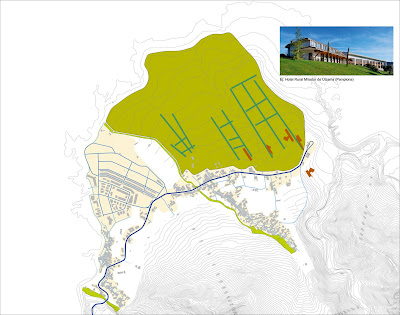 Alternative 2: Tourist establishments linked to agriculture Alternative 2: Tourist establishments linked to agriculture- Intervention in the neighborhoods of La Hoya and The Homician. The goal is to treat the neighborhoods of La Hoya and El Homicián since its structure suffers from certain aspects morfotipológica ending to define its urban. Both present difficulties of access, housing quality, endowments, etc..
 Views from The Homician Views from The HomicianTo Low tide studied the following aspects:
-Improvements to the existing road structure. Bajamar core accessibility presents some problems associated with the absence of cross suitable for access to the central, roads with insufficient section for traffic along with a remarkable lack of parking that disproportionately affects users of the natural pools summer. This requires improvements to the current road network or creating a new variant to the TF-13 South.
- Basic proposals in the palm of Low Tide. For this large area south of the town of Bajamar alternatives arise as microparque creating an environmental theme or incorporating a recreational sports facility character that could be complemented by tourist establishments alojativos.

Alternative 3: Generating a recreational sporting facility
- Port infrastructure in Low Tide and The Point. Contemplate deployment options port infrastructure in the Northeast coast of La Laguna (comprising of Low tide coastal fronts and Punta del Hidalgo).
In Tejina proposed these discussion topics:
- Management of singular residential areas. It includes the addition of two vacant areas, one north and one south of Tejina, they have enough surface dimension to conform as unique areas. For location and insertion in the urban, must have global use residential; however, its size and make it desirable urban function arising basic options for management, unlike other parts whose small size vacancy ordering schemes force the.
- Spatial unique area south edge of Tejina. Among Tejina and Tegueste, in the municipality of La Laguna, there are still undeveloped land that acquire a special strategic value for the auction and urban conformation of both cores. The thematic scope is defined exactly for this border area treated as a unique area of Tejina for which can be raised basic management alternatives. The alternatives are defined by the global use to apply in this area among them tertiary mixed use, Industrial and agricultural.
To Valle de Guerra these alternatives include:
-Improvements to the existing road structure. The objective is to evaluate the new elements that could be introduced to improve road infrastructure of Valle de Guerra. We propose new ways north, South and even in the field this nucleus central semivacante. The development of these pathways or not is defined by the urban growth model chosen.

Alternative 3. Creating new road network in the core areas of Valle de Guerra. Via linked to reserve free space for parking, comfortable bicycle lanes and pedestrian circulation.
- Spaces of centrality. In this section we study the possibilities to equip War Valley structuring axis of the core economic activity.
-New production. This theme aims to raise the various options for the management of a territory to the kernel entry that could house production activities, contributing significantly to the development of Valle de Guerra. For this study the possibility of holding a new exhibition ground east of Valle de Guerra where mixed uses could be located tertiary, industrial or agricultural uses high production.
In addition to the issues identified for each core alternatives have been studied delimitation and kernel extension, to determine the most appropriate growth model.

Extension and delimitation of urban core Tejina
|
|

 Ruhr
Ruhr





 The new Amazon Kindle
The new Amazon Kindle







